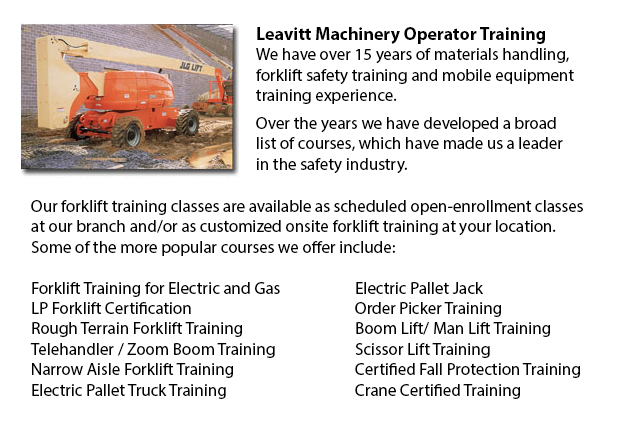
Boom Lift Certification Burlington - Utilizing elevated work platforms allow for maintenance operations and work to be done at elevated work heights that were otherwise not reachable. Workers using boom lifts and scissor lifts can learn how to safely operate these machines by receiving boom lift certification training.
Despite the variety in lift style, site conditions and applications, all lifts have the potential for serious injury or death when not safely operated. Falls, electrocution, tip-overs and crushed body parts can be the unfortunate outcome of incorrect operating procedures.
To be able to prevent aerial lift incidents, individuals have to be qualified to be able to train workers in operating the certain type of aerial lift they would be utilizing. Controls should be easily accessible beside or in the platform of boom lifts used for carrying workers. Aerial lifts should not be be modified without the express permission of the manufacturer or other recognized entity. If you are leasing a lift, make sure that it is maintained correctly. Before utilizing, safety devices and controls need to be checked to be able to ensure they are working properly.
Operational safety procedures are essential in avoiding incidents. Operators should not drive an aerial lift with an extended lift (even though a few are designed to be driven with the lift extended). Always set brakes. Set outriggers, if available. Avoid slopes, but when necessary utilize wheel chocks on slopes that do not exceed the slope restrictions of the manufacturer. Follow weight and load limitations of the manufacturer. When standing on the boom lift's platform, make use of a safety belt with a two-foot lanyard tied to the basket or boom or a full-body harness. Fall protection is not necessary for scissor lifts that have guardrails. Do not sit or climb on guardrails.
The boom lift certification course provides instruction in the following areas: safety guidelines to be able to prevent a tip-over; training and certification; surface conditions and slopes; checking the work area & travel path; stability factors; other guidelines for maintaining stability; weight capacity; leverage; pre-operational check; testing control functions; mounting a vehicle; safe operating practices; power lines and overhead obstacles; safe driving procedures; use of lanyards and harness; PPE and fall protection; and preventing falls from the platform.
When successful, the trained worker will know the following: pre-operational check procedures; authorization and training procedures; how to prevent tip-overs; factors affecting the stability of boom and scissor lifts; how to utilize the testing control functions; how to utilize PPE and strategies to avoid falls.
-
Order Picker Training Burlington
Order Picker Training Burlington - Order picker's enables warehouse employees to lift pallets using forks. Also called a stock picker, this particular electrically-powered equipment is similar to a forklift except that an order picker is likewise uti... More -
Crane Certification Burlington
Crane Certification Burlington - The Crane Certification training program includes content recommended by industry regarding the efficient and safe operation of cranes. Trainees would learn the following: how to identify cranes and their component pa... More -
Overhead Crane Training Burlington
Overhead Crane Training Burlington - The overhead crane is a piece of equipment which can lift and move huge, heavy objects which can't be handled by hands. Typically, overhead cranes are fixed in place. These equipment are capable of moving huge vol... More -
Aerial Lift / Boom Lift / Man Lift / Scissor Lift Training in Burlington
Lift tables or scissor lifts could elevate both people and goods vertically. They are normally used in construction, commercial and industrial environments. Commonly, the use of a scissor lift is to lift and lower supplies from one floor of a job loc... More -
Telehandler Operator Training Burlington
Telehandler Operator Training Burlington - Telescopic Handler forklifts or telehandler forklifts are usually found on construction places and their popularity continues to rise. The versatility of telehandler forklifts ensures that they are a valuabl... More -
Forklift Training Classes Burlington
Forklift Training Classes Burlington - Forklift are heavy pieces of industrial machines that are made use of in transporting and the handling of merchandise and materials. They are often known as Lift trucks and are found in all sorts of businesses.... More -
Boom Lift Training Burlington
Boom Lift Training Burlington - Aerial platforms or also known as elevated work platforms are devices that allow workers to perform tasks and duties at elevated heights that would not be otherwise accessible. There are a variety of aerial lifts avail... More -
Bucket Truck Training Burlington
Bucket Truck Training Burlington - The Vehicle-Mounted Aerial Work Platform or also called bucket truck training program is intended to decrease the risk of incident and personal injury while working in close proximity or with bucket trucks by effici... More

Forklift Training Burlington
TOLL FREE: 1-888-254-6157
Burlington, Ontario
forklifttrainingburlington.com
Email Us
About Us


